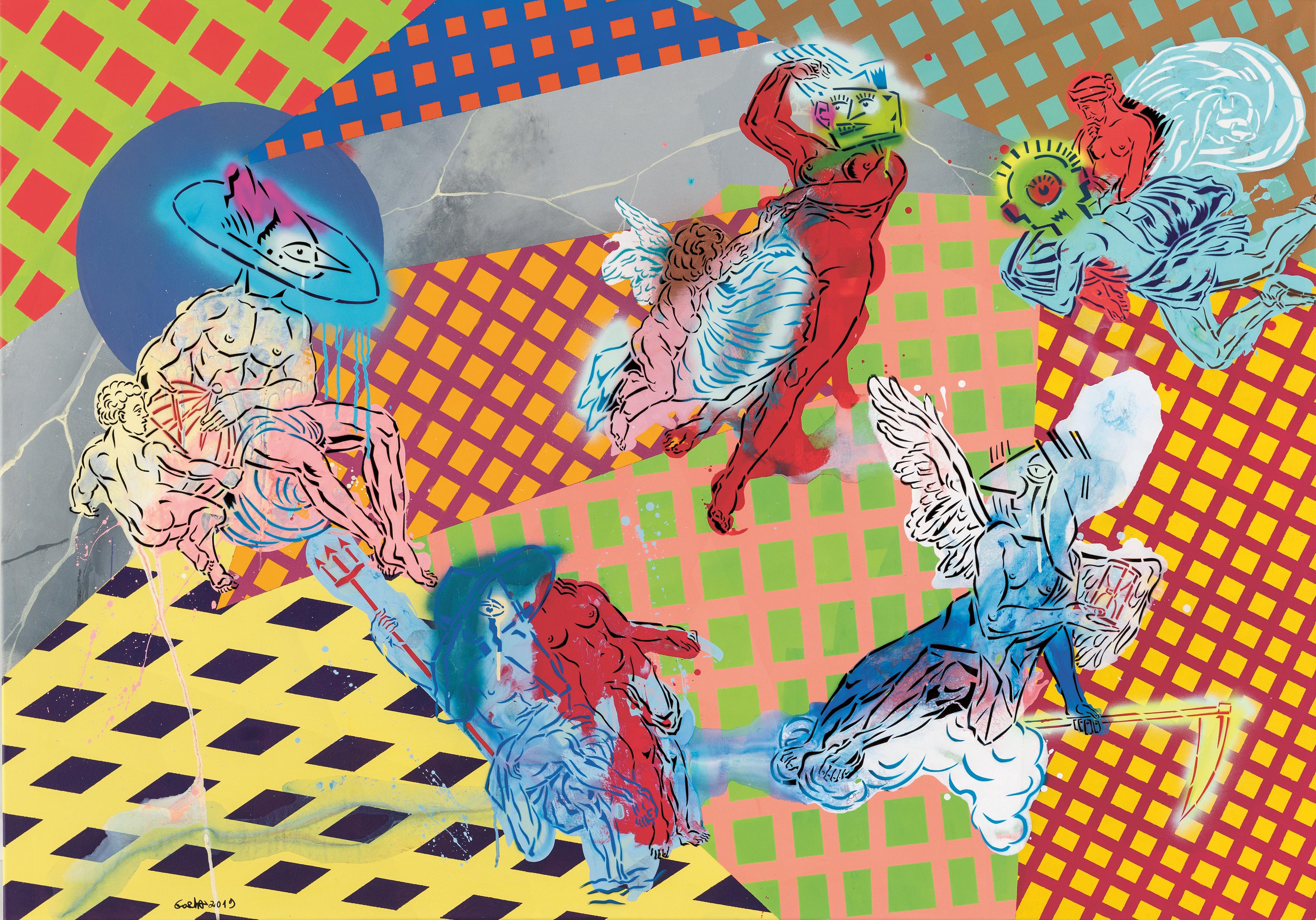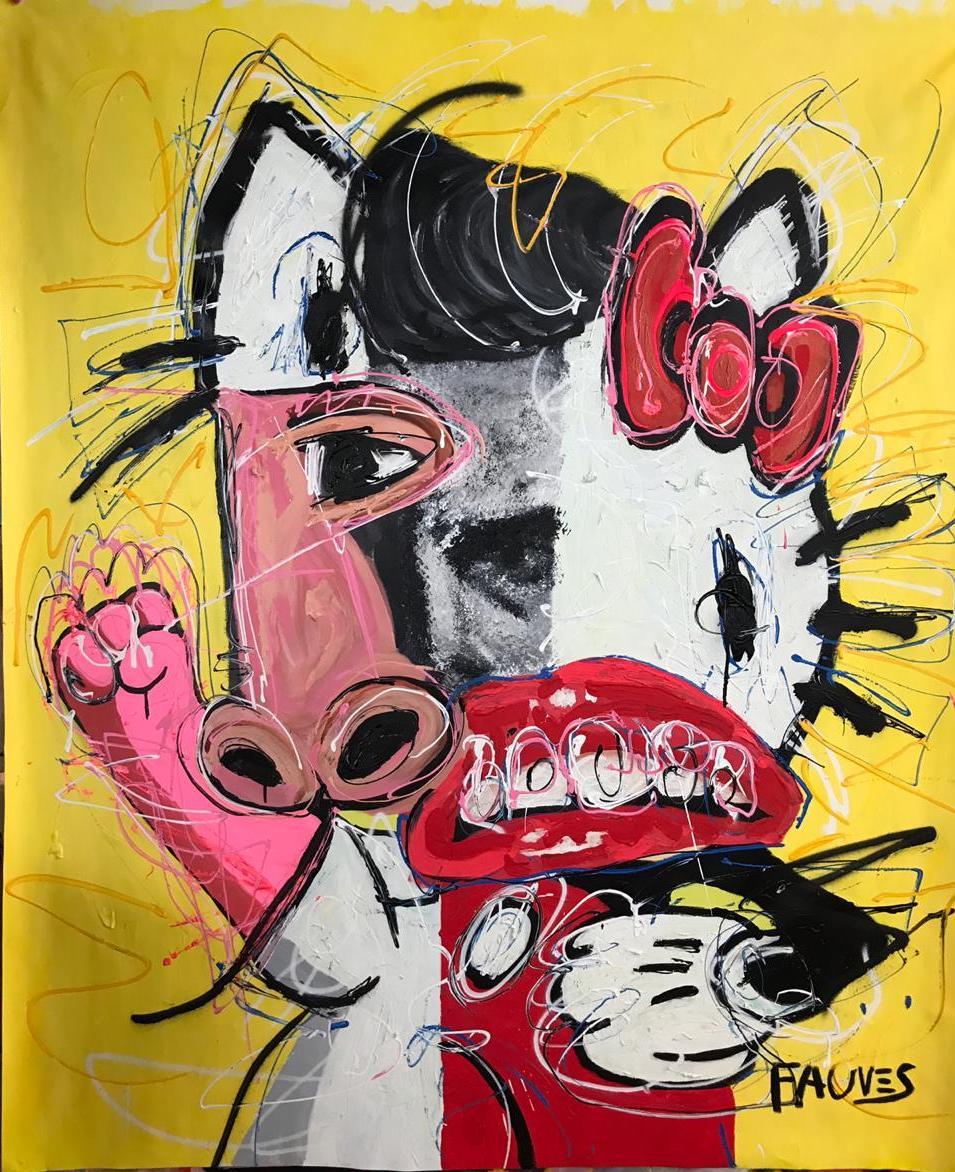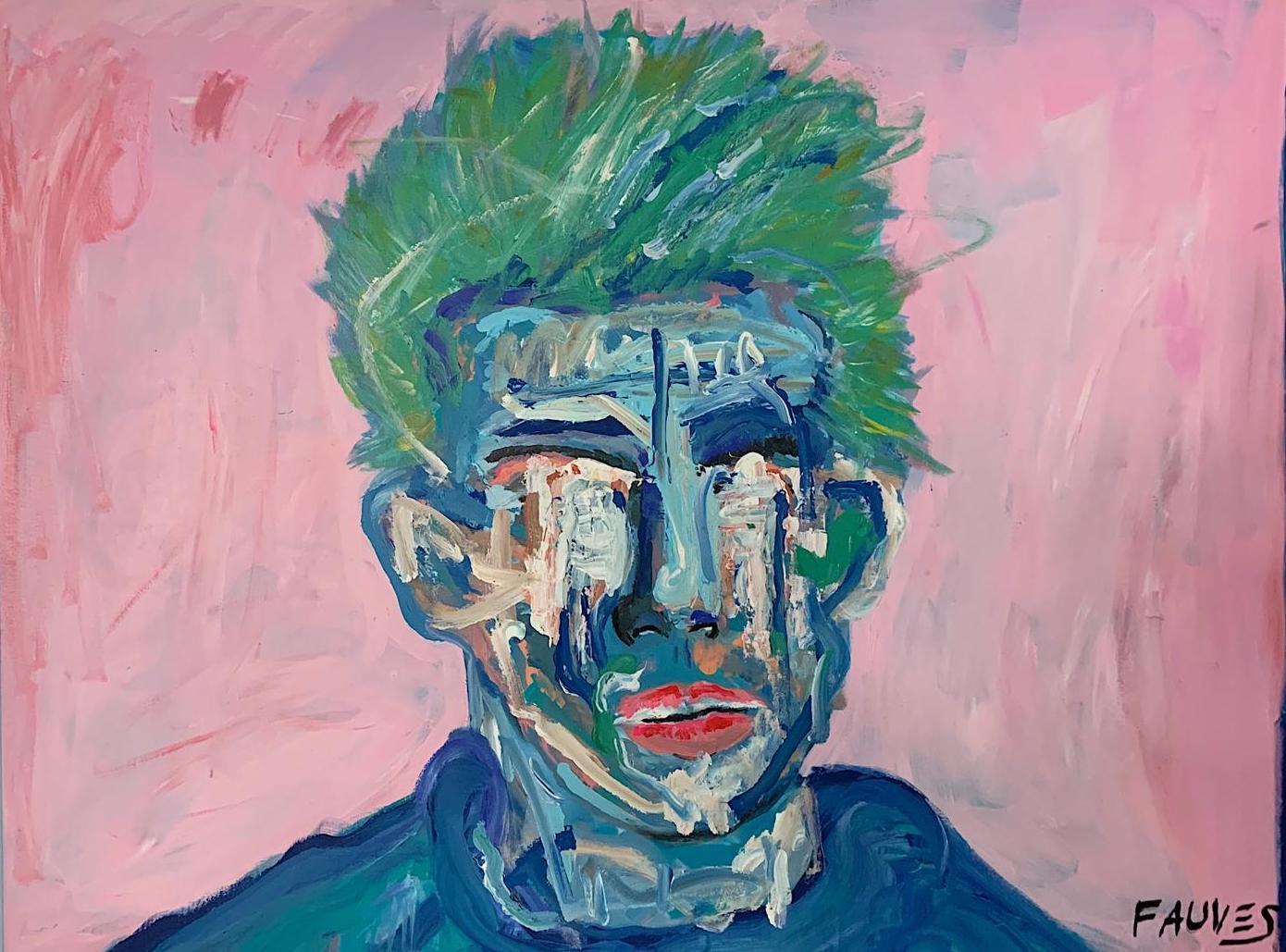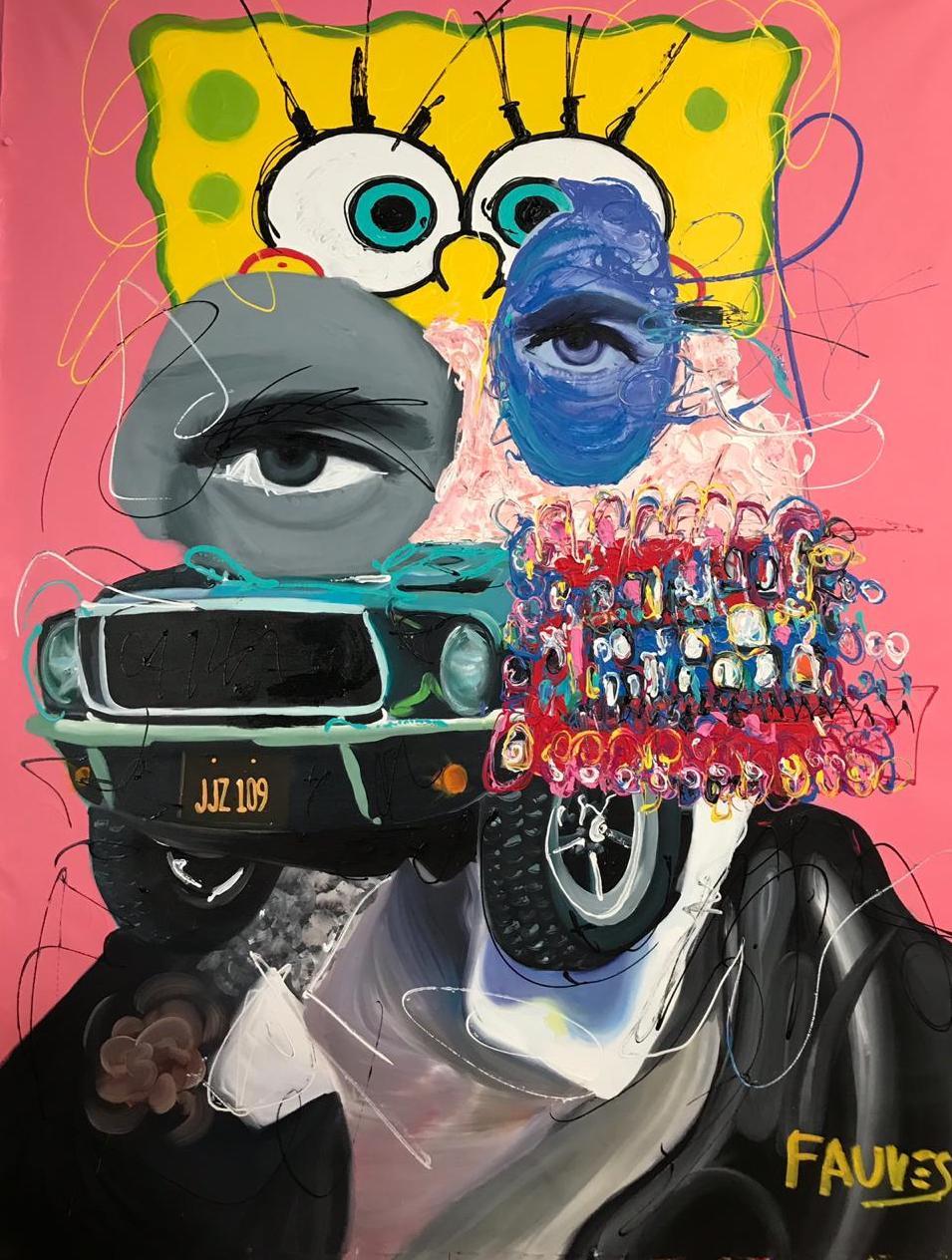Items Similar to "Inside the Black Diamond, " Lila Katzen, Pop Art, Color Field Female Abstract
Want more images or videos?
Request additional images or videos from the seller
1 of 8
Lila Katzen"Inside the Black Diamond, " Lila Katzen, Pop Art, Color Field Female Abstract1964
1964
About the Item
Lila Katzen
Inside the Black Diamond, 1964
Signed, titled, and dated on the reverse
Acrylic on canvas
30 x 24 inches
Lila Katzen said of her pieces in all media: “I feel marvelous when my works find a home. They are like my children. They are my links to the past. They are what I am.”
Born in 1932, in Brooklyn, Katzen began studying painting at the Art Students League. She continued her studies and earned a BFA at The Cooper Union, New York City. Katzen later attended the Hans Hoffman School of Art in New York and Provincetown, MA. An accomplished painter, in 1955, Katzen had her first solo exhibition at the Baltimore Museum of Art. In 1962, Katzen accepted a position at the Maryland Institute, College of Art—she remained on the faculty until 1980. An encounter with renowned sculptor George Segal in 1964 prompted Katzen to focus her attention on sculpture, and she became interested in Minimalism. Her sculpture, Liquid Tunnel, comprised of light and fluorescent liquid, for the 1970 Sao Paulo Biennale won her international attention. During the early 1970’s, Katzen moved away from the philosophies of Minimalism, and instead, chose to create works that encouraged human interaction. This decision led Katzen to push stainless steel and aluminum to creative heights in the 1980s and 1990s—resulting in works that were not only aesthetically striking, but laden with meaningful content relevant to society and humanity. Katzen passed away on September 20, 1998 in New York City.
During her prolific career as an artist, Katzen was awarded a number of solo exhibitions including shows at the Montgomery Museum of Art in Alabama (1996) and Lila Katzen: Force I at Wichita State University’s Edwin A. Ulrich Museum of Art, Kansas (1995)—her participation in group exhibitions is equally extensive. Her works are in collections at the De Cordova Museum and Sculpture Park, Lincoln, MA; Baltimore Museum of Art, MD; the Birmingham Museum of Art, AL; the Chrysler Museum of Art, Norfolk, VA; the Georgia Museum of Art in Athens; the National Gallery of Art, Washington, DC; The J. Paul Getty Museum, Santa Monica, CA; and Wadsworth Atheneum Museum of Art, Hartford, CT.
- Creator:Lila Katzen (1932 - 1998, American)
- Creation Year:1964
- Dimensions:Height: 30 in (76.2 cm)Width: 24 in (60.96 cm)
- Medium:
- Movement & Style:
- Period:
- Condition:
- Gallery Location:New York, NY
- Reference Number:1stDibs: LU1841211650342
About the Seller
5.0
Platinum Seller
These expertly vetted sellers are 1stDibs' most experienced sellers and are rated highest by our customers.
Established in 2021
1stDibs seller since 2022
59 sales on 1stDibs
Typical response time: 1 hour
- ShippingRetrieving quote...Ships From: Larchmont, NY
- Return PolicyA return for this item may be initiated within 3 days of delivery.
More From This SellerView All
- "Untitled, " Knox Martin, Abstract ExpressionismBy Knox MartinLocated in New York, NYKnox Martin (1923 - 2022) Untitled Signed to lower edge Acrylic and gold foil on canvas 9 x 9 inches Knox Martin (1923-2022) was an esteemed New York School painter. Knox Martin was born in 1923 in Barranquilla, Colombia. He was the son of the aviator, painter, and poet William Knox Martin, the first man to fly over the Andes Mountains. After serving in World War II, Knox Martin attended the Art Students League of New York on the G.I. Bill from 1946-1950, where he studied with Harry Sternberg, Vaclav Vytlacil, Will Barnet, and Morris Kantor. In 1954, Knox Martin's friend Franz Kline placed a painting of his in the Stable Gallery Annual. Charles Egan of the renowned Charles Egan Gallery saw Knox Martin's painting at the Stable Gallery and asked Martin to show his work in a one-man show for the tenth anniversary of the Egan Gallery. Since then, Knox Martin was a celebrated painter, sculptor and muralist. Knox Martin had an extensive exhibition record and his work is in museum, corporate and private collections worldwide. His two best-known murals in NYC are Venus and Woman with Bicycle...Category
Late 20th Century Abstract Abstract Paintings
MaterialsGold, Foil
- "Night Road" Gerome Kamrowski, Abstract Expressionism Surrealism, Purple ImpastoBy Gerome KamrowskiLocated in New York, NYGerome Kamrowski (1914 - 2004) Night Road, 1966 Acrylic on canvas 58 1/4 x 96 1/4 inches Signed and dated Provenance: The Artist The Kamrowski Estate (by family descent in 2004) Exhibited: The Detroit Institute of Arts, Detroit, Michigan, 56th Exhibition for Michigan Artists, November 18 - December 31, 1966, no. 32, illustrated (Night Road was the winner of the "Phyllis King Weiner Memorial Prize" at this exhibition). Ann Arbor, University of Michigan Museum of Art, Gerome Kamrowski: A Retrospective Exhibition, August 30 - October 16, 1983, no. 70, illustrated. Tarpon Springs, Florida, Leepa-Rattner Museum of Art, St. Petersburg College, Gerome Kamrowski: An American Surrealist, September 8 - October 27, 2002, no. 23. Chelsea, Michigan, River Gallery, Gerome Kamrowski: 1914-2004, A Memorial Retrospective, October 30 - December 5, 2004. Gerome Kamrowski was born in Warren, Minnesota, on January 19, 1914. In 1932 he enrolled in the Saint Paul School of Art (now Minnesota Museum of American Art - MMAA), where he studied with Leroy Turner, and Cameron Booth. Both Turner and Booth had been students of Hans Hofmann, and were also associated with the Abstraction-Création group in Paris. It was from these peers that Kamrowski was introduced to a "kind of expressionist cubism." In 1933 Kamrowski was awarded a scholarship to the Art Students League, where he would study in New York under Hans Hofmann. Unfortunately, immigration problems had prevented Hofmann from assuming his post. Nevertheless, Kamrowski decided to remain in New York for a short time, to attend classes taught by George Grosz. After a few weeks, he returned to St. Paul, and found a position in the mural painting division of the Minnesota FAP/WPA (Works Progress Administration). In 1936 he contributed “Synthetic Cubist Style” frescoes in the Northrup Auditorium of the University of Minnesota. In 1937 Kamrowski went to Chicago to study under László Moholy-Nagy and Alexander Archipenko at the New Bauhaus (now Illinois Institute of Technology's Institute of Design). There he was exposed to new and interesting ideas regarding the role of nature in art and the "geometric basis of natural form". In 1938 Kamrowski received a Guggenheim fellowship to attend Hans Hofmann's summer school in Provincetown, Massachusetts. He then relocated to New York where he met William Baziotes. Together they shared a fascination in Surrealist automatic writing, and both artists explored its possibilities in their paintings. Kamrowski was particularly drawn to Surrealism's fundamental appeal of intuition over intellect. He was interested seeking a process that "binds all things together...a kind of cosmic rhythm". Throughout the late 1930s and early 1940s while living in New York, Kamrowski became an integral part of the emerging surrealists. In 1942, the artist Roberto Matta attempted to form a group of artists to investigate new applications for Surrealist methods. He invited Kamrowski, along with William Baziotes, Jackson Pollock, Peter Busa...Category
1960s Abstract Expressionist Abstract Paintings
MaterialsCanvas, Acrylic
- "Untitled, " Sherron Francis, Female Abstract Expressionism, White ImpastoBy Sherron FrancisLocated in New York, NYSHERRON FRANCIS (AMERICAN, B. 1940) Untitled, 1977 Acrylic on canvas 33 x 27 1/2 inches Signed, titled and dated on the reverse A reappraisal is long ...Category
1970s Abstract Expressionist Abstract Paintings
MaterialsCanvas, Acrylic
- "Cepheus B, " Yeffe Kimball, Female Native American Abstract ExpressionistLocated in New York, NYYeffe Kimball (c. 1905 - 1978) Cepheus B, 1963 Signed, titled, and dated on the reverse Acrylic on canvas 34 x 40 inches Provenance: Private Collection, New York Estate of the above, 2022 Born in Mountain Park, Oklahoma, in 1914, Effie Y. Goodman subsequently spent her early years on her grandfather’s farm in Missouri. She attended college in Ada and the University of Oklahoma in Norman from 1931-1935. After college, she went to New York where she worked under distinguished artists such as George Bridgman and John Corbin at The Art Students League in New York in the early 1940s. She adopted the name Yeffe Kimball, adapting her first husband's surname of Campbell to form Kimball, and never returned to her small-town roots. She became a world traveler and student, studying intermittently with Fernand Léger in Paris from 1940-1941. In 1948, she married Harvey L. Stalin, an atomic scientist. Her art was influenced by Stalin’s work and she entered a new era, focusing on burning planets, atmospheric gases, and flashing comets. Her work was also inspired by American Indian spiritual...Category
1960s Abstract Expressionist Abstract Paintings
MaterialsCanvas, Acrylic
- "Lexington, " Larry Zox, Abstract Expressionism, Minimalism, Brown ModernismBy Larry ZoxLocated in New York, NYLarry Zox Lexington, 1973 Acrylic on canvas 61 x 49 inches Provenance: Andre Emmerich Gallery, New York Janie C. Lee Gallery, Houston, Texas Private Collection, Greenwood Village, Colorado Exhibited: New York, Andre Emmerich Gallery, Larry Zox: New Paintings, March 10 - 28, 1973. Houston, Texas, Janie C. Lee Gallery, Larry Zox, February - April, 1974. A painter who played an essential role in the Color Field discourse of the 1960s and 1970s, Larry Zox is best known for his intensely and brilliantly colored geometric abstractions, which question and violate symmetry. Zox stated in 1965: “Being contrary is the only way I can get at anything.” To Zox, this position was not necessarily arbitrary, but instead meant “responding to something in an examination of it [such as] using a mechanical format with X number of possibilities." What he sought was to “get at the specific character and quality of each painting in and for itself,” as James Monte stated in his introductory essay in the catalogue for Zox’s 1973–74 solo exhibition at the Whitney Museum of American Art. Zox also at times used a freer, more intuitive method, while maintaining coloristic autonomy, which became increasingly important to him in his later career. Zox began to receive attention in the 1960s, when he was included in several groundbreaking exhibitions of Color Field and Minimalist art, including Shape and Structure (1965), organized by Henry Geldzahler and Frank Stella for Tibor de Nagy, New York, and Systemic Painting (1966), organized by Lawrence Alloway for the Guggenheim Museum. In 1973–74, the Whitney’s solo exhibition of Zox’s work gave recognition to his significance in the art scene of the preceding decade. In the following year, he was represented in the inaugural exhibition of the Hirshhorn Museum, which acquired fourteen of his works. Zox was born in Des Moines, Iowa. He attended the University of Oklahoma and Drake University, and then studied under George Grosz at the Des Moines Art Center. In 1958, Zox moved to New York, joining the downtown art scene. His studio on 20th Street became a gathering place for artists, jazz musicians, bikers, and boxers. He occasionally sparred with visiting fighters. He later established a studio in East Hampton, a former black smithy used previously by Jackson Pollock. Zox’s earliest works were collages consisting of pieces of painted paper stapled onto sheets of plywood. He then produced paintings that were illusions of collages, including both torn- and trued-edged forms, to which he added a wide range of strong hues that created ambiguous surfaces. Next, he omitted the collage aspect of his work and applied flat color areas to create more complete statements of pure color and shape. He then replaced these torn and expressive edges with clean and impersonal lines that would define his work for the next decade. From 1962 to 1965, he produced his Rotation series, at first creating plywood and Plexiglas reliefs, which turned squares into dynamic polygons. He used these shapes in his paintings as well, employing white as a foil between colors to produce negative spaces that suggest that the colored shapes had only been cut out and laid down instead of painted. The New York Times noted in 1964: “The artist is hip, cool, adventurous, not content to stay with the mere exercise of sensibility that one sees in smaller works.” In 1965, he began the Scissors Jack series, in which he arranged opposing triangular shapes with inverted Vs of bare canvas at their centers that threaten to split their compositions apart. In several works from this series, Zox was inspired by ancient Chinese water vessels...Category
1970s Abstract Expressionist Abstract Paintings
MaterialsCanvas, Acrylic
- "Trap Rock, " Sherron Francis, Female Abstract Expressionism, Blue Color FieldBy Sherron FrancisLocated in New York, NYSHERRON FRANCIS (AMERICAN, B. 1940) Trap Rock, 1972 Acrylic on canvas 22 3/4 x 16 inches Signed, titled and dated on the reverse A reappraisal is long overdue for the second-generation abstract expressionists. Artists such as Helen Frankenthaler, Morris Louis, Dan Christensen, and Sam Francis are already well-known names. However, Sherron Francis, a female artist from the Midwestern United States, exhibited alongside many of these stars, yet has not been the recipient of a major exhibition in nearly 40 years. Francis was born in the Chicago suburb of Downers Grove, Illinois in 1940. She studied fine art at the University of Oklahoma from 1958 to 1960 before transferring to the Kansas City Art Institute for better educational opportunities. At the time, Francis remained loyal to figurative art. Philip Pearlstein, a contemporary artist and visiting professor once remarked at the confidence of Francis’ draftsman abilities. In the early 1960s, art dealers and gallerists from New York would visit the Institute to recruit artists by offering scholarships, but they only offered these scholarships to men. Francis was forced to plead with deans to allow a scholarship for women so that she could continue her studies. She ultimately graduated from the Kansas City Art Institute in 1963. In Missouri, Francis met Dan Christensen (Class of 1964), an artist friend, who would play a key role in her career throughout the next two decades. Francis then received her MFA from the University of Indiana, where she was housemates with Mernet Larsen, before assuming a teaching position at Eastern Michigan University. In 1968, with only $300 on hand, Francis moved to 16 Waverly Place in Soho. At the time, the neighborhood boasted some of the biggest names in abstract expressionism. She quickly became friends with Peter Reginato, Walter Darby Bannard, Michael Steiner, Peter Young, Larry Zox, and Larry Poons, who all lived and worked in the neighborhood. In fact, Francis introduced Larry Poons to his now wife, Paula, a friend and student of Sherron’s. Francis helped to found The Bowery Gallery in 1969 and received her first solo exhibition there in 1970 for her figurative works. After this exhibition, Francis decided to switch to abstraction. By 1971, Christensen, who was exhibiting with Andre Emmerich, introduced Francis to the legendary gallerist. There was no better gallery to be showcasing abstract expressionism and color field painting during this decade for an artist. For example, in 1972, Emmerich held solo exhibitions by art titans, such as Hans Hofmann, Al Held, Esteban Vicente, David Hockney, and Morris Louis. In 1973 alone, Emmerich gave one-person exhibitions to Helen Frankenthaler, Kenneth Noland, Hans Hofmann, Jack Bush and a new discovery: 32-year-old Sherron Francis. The January 27 - February 14 exhibition for Francis was a great success with Peter Schjeldahl commenting in the New York Times: “Francis has…sidestepped the danger of seeming hopelessly derivative of such artists as Mark Rothko, Morris Louis and Helen Frankenthaler —by, it seems to me, the use of a single canny formal device. All her canvases are tall, vertical rectangles. What this shape achieves is a physical presence that supports the paintings' fragile play of color and texture. Bearing roughly the proportions of the human body, but bigger in size, her pictures confront the viewer with a satisfying firmness, inviting delectation.” Francis’s career now took off with the stain paintings. In a 1974 article in Arts Magazine, Whee Kim writes, “She has asserted the credibility of her own answer to the problem of the outer edge of a canvas by limiting her investigations to a singular central image. In her variations on this theme, an intuitive sense of color and touch is given restricted free-play.” Schjeldahl added, “Her paintings, stained and brushed to a suavely grainy texture, each float an area of warm, soft color in a somewhat less‐intensely colored field. The areas are amorphous in shape and closely related, by hue, to the surrounding fields. Her colors run to luxurious brown‐golds, dreamy bluegreens and dusty pinks, though each canvas is alive with a variety of evanescent hues and tints. The goal of her art is to be at once as gorgeous and as delicate as possible: she intends to ravish.” In 1973, Francis exhibited at the Whitney Biennial and then received a second solo exhibition at Emmerich the following year. Corporate collections and private enthusiasts, including Helen Frankenthaler, rushed to purchase her paintings. More than sixty of her paintings sold in one year at Emmerich’s gallery. Throughout the 1970s and early 1980s, Francis exhibited at other leading American galleries, including Janie C. Lee Gallery in Houston, Barbara Kornblatt Gallery in Baltimore, Douglas Drake in Kansas City, Rubiner Gallery in Detroit, and Tibor de Nagy Gallery in New York. Francis always marched to the beat to her own drum. Although she admired the works of Jules Olitski, Jack Bush, and Kenneth Noland, Francis never felt that her work and lifestyle were influenced by others. When her friends summered in the...Category
1970s Abstract Expressionist Abstract Paintings
MaterialsCanvas, Acrylic
You May Also Like
- "Incomplete Solar System" Painting 55" x 79" inch by Gosha OstretsovBy Gosha OstretsovLocated in Culver City, CA"Incomplete Solar System" Painting 55" x 79" inch by Gosha Ostretsov Acrylic & enamel on canvas Born in 1967, in Moscow Lived in Paris for ten years (1988 - 1998), now lives and wo...Category
20th Century Pop Art Abstract Paintings
MaterialsEnamel
- "Saturn" Painting 39" x 39" inch by Gosha OstretsovBy Gosha OstretsovLocated in Culver City, CA"Saturn" Painting 39" x 39" inch by Gosha Ostretsov Acrylic & enamel on canvas Born in 1967, in Moscow Lived in Paris for ten years (1988 - 1998), now lives and works in Moscow. P...Category
20th Century Pop Art Abstract Paintings
MaterialsCanvas, Acrylic
- "Hello Dean" Mixed media Painting 67x54 inch by John Paul FauvesBy John Paul FauvesLocated in Culver City, CA"Hello Dean" Mixed media Painting 67x54 inch by John Paul Fauves From "Alts iz farloyrn" ("All is lost") series 2019 Mixed media, acrylic and oil on canvas 63" × 53" inch "Alts iz farloyrn" ("All is lost") "Alts iz Farloyrn” – the latest series by John Paul Fauves featuring large-scale mixed media paintings, sculptures, and his famous art masks. Inspired by American idols James Dean and Steve McQueen, "Alts iz Farloyrn,” which translates to "All is Lost," was Steve McQueen’s first ever line on stage and represents Fauves own struggle with losing it all yet discovering his true self. “Alts iz Farloyrn” dives deep into the darkness that surrounded James Dean and Steve McQueen and explores their need to live fast. Through this new series, viewers are reminded that although both men overcame challenges to become the Hollywood elite, they struggled to mentally escape their troubled childhood and demons. Recognized internationally for his Neo-Pop Expressionism, Fauves paintings deal with identity through art, mainstream culture and social media. About this series, Fauves says “I have personally lost it all and what I’ve learned is when you lose it all you can win it all again and create a new beginning!” ABOUT John Paul FAUVES: John Paul Fauves (born in 1980) is a contemporary Artist from Costa Rica . His artistic journey started at a very young age after he became a student of Joaquin Rodriguez del Paso , one of the most important Costa Rican modern art tutors. John Paul spent 15 years studying and mastering his technique, and only a few years ago he finally started showcasing his work. In his paintings he engages questions of identity as they relate to art history as well as our everyday interactions with mainstream culture and social media. Greatly inspired by modernist masters as wellas pop-artists, Fauves mixes fragments of different iconic images in vivid and colourful compositions. Of his experimental and high eclectic style, he says, “art is an expression from the soul, and the soul is somethinglimitless. This is why I am always searching for different elements to bring into the work.” 2019: Alts Iz farloyrn, Los Angeles, CA Portraits of Someone, London 2018: [ Mi / Me ] solo exhibition at DOPENESS ART LAB, Taipei, Taiwan Arte de La Peer Papi Chulo group exhibition, Krause gallery, NYC Down the Rabbit Hole group exhibition, Imitate London, London, UK ARCO Madrid Art Palm Beach, Miami 2017: Art Basel Miami PIXELS Pre-Basel group exhibition by JM Art Management at Laurent & Martin gallery LA Style Fashion week FACES, group exhibition by JM Art Management at HOMME gallery A Loss of Innocence, solo exhibition Guy Hepner...Category
21st Century and Contemporary Pop Art Figurative Paintings
MaterialsCanvas, Mixed Media, Oil, Acrylic
- "James Dean" Mixed Media Painting 48" x 68" in by John Paul FauvesBy John Paul FauvesLocated in Culver City, CA"James Dean" Mixed Media Painting 48" x 68" in by John Paul Fauves 2018 ABOUT John Paul FAUVES: John Paul Fauves (born in 1980) is a contemporary Artist from Costa Rica . His ar...Category
21st Century and Contemporary Pop Art Figurative Paintings
MaterialsCanvas, Mixed Media, Oil, Acrylic
- "Self Portrait" Acrylic on canvas Painting 46" x 78" inch by Ty JosephBy Ty JosephLocated in Culver City, CA"Self Portrait" Acrylic on canvas Painting 46" x 78" inch by Ty Joseph From 7 L's series 2018 * * * The meaning of L series * * * Although influenced by Pop Art, with its bold, ey...Category
21st Century and Contemporary Pop Art Abstract Paintings
MaterialsCanvas, Acrylic
- "Hockney" Acrylic on canvas Painting 36" x 36" inch by Ty JosephBy Ty JosephLocated in Culver City, CA"Hockney" Acrylic on canvas Painting 36" x 36" inch by Ty Joseph From 7 L's series 2018 acrylic on canvas 36" x 36" * * * The meaning of L series * * * Although influenced by Pop...Category
21st Century and Contemporary Pop Art Abstract Paintings
MaterialsCanvas, Acrylic
Recently Viewed
View AllMore Ways To Browse
Pop Art Retro Art
What Is Retro Art
Art 30x24
National Gallery Art Washington
Inside Painting
Vintage Female Art
Vintage Art Aesthetic
Vintage Aesthetic Art
Art Of Washington Dc
Washington State Art
Washington Dc Art
Aesthetic Retro Art
Kansas Art
Retro Female Art
Retro Pop Art Painting
Pop Art Light
1964 Abstract
Baltimore Art





